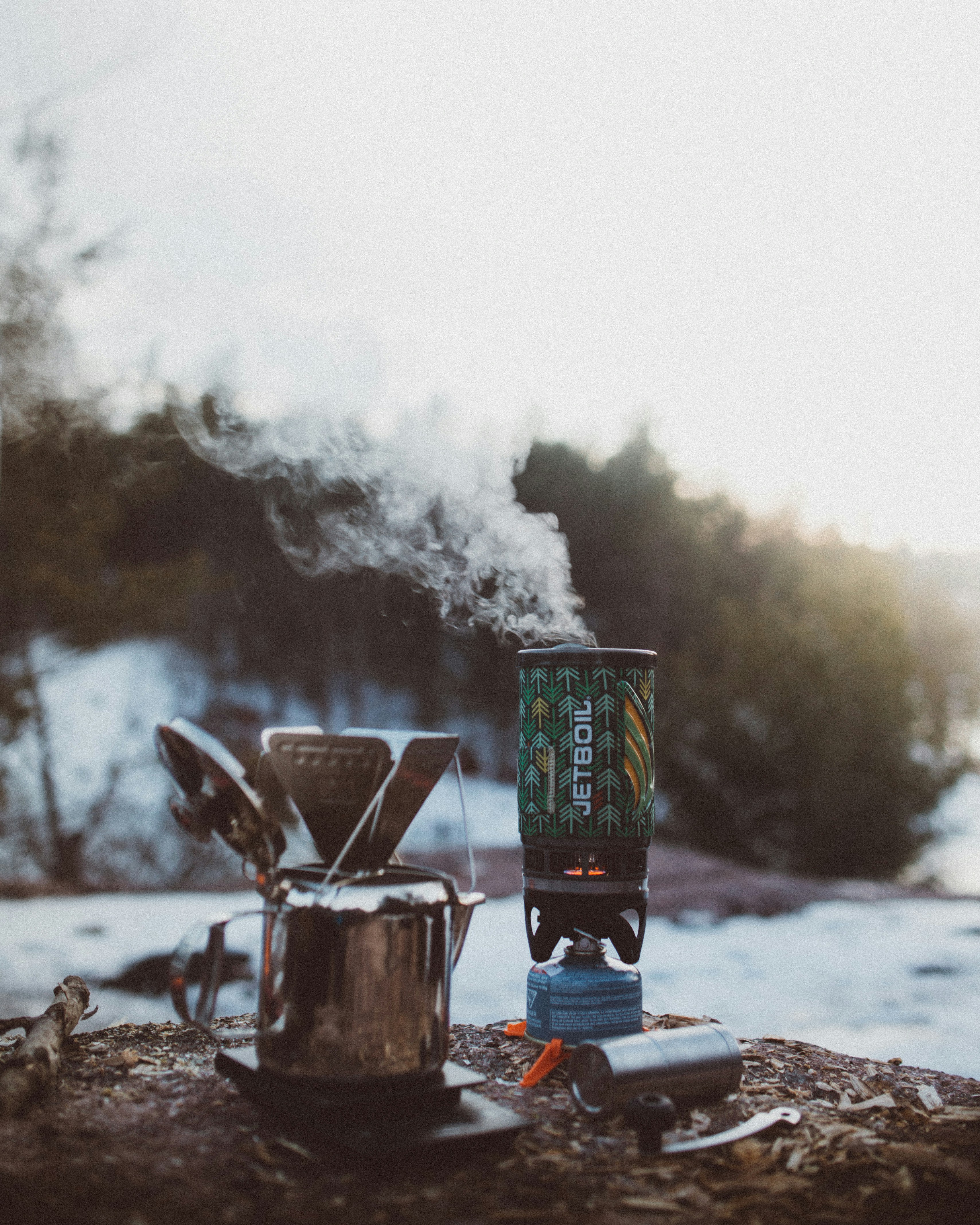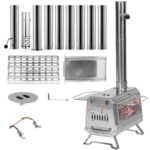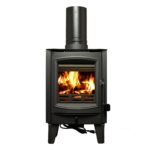
Introduction to Portable Wood Burning Stoves
Portable wood burning stoves are a practical and environmentally-friendly option for campers searching for efficient cooking solutions. Unlike traditional gas or propane stoves, which rely on fuel supplies, wood burning stoves utilize renewable biomass as a fuel source, offering a sustainable alternative. This unique feature makes them particularly appealing to those who prioritize eco-friendliness and wish to minimize their carbon footprint while enjoying the great outdoors.
A wood burning stove operates by converting wood into heat energy through combustion, providing a reliable and consistent source of heat for cooking and warmth. This method of cooking boasts several advantages. Firstly, wood is often readily available in many camping areas, making it a convenient choice for hikers and adventurers who may not want to carry additional fuel sources. Secondly, using wood allows campers to reduce dependency on fossil fuels, thus supporting sustainable practices while enjoying nature.
Additionally, portable wood burning stoves tend to be lightweight and compact, designed for easy transport and setup at campgrounds. Some models even feature advanced technologies that enhance efficiency and promote complete combustion, thereby minimizing smoke and reducing environmental impact. The versatility of these stoves also extends to their ability to function in various weather conditions, making them a reliable choice regardless of the season.
In comparison to other camping stoves, such as those that operate on liquid fuel or gas, portable wood stoves often require less maintenance and are structurally simpler, which can appeal to novice campers. Understanding these stoves and their benefits can significantly enhance one’s camping experience, providing practical solutions for cooking and heating, while fostering a deeper connection with the natural environment.
Advantages of Using Portable Wood Burning Stoves
Portable wood burning stoves offer several advantages that make them an ideal choice for camping enthusiasts. One of the most significant benefits is their lightweight design, which allows for easy transportation. Many models are constructed from durable yet lightweight materials, making them suitable for backpackers and campers who prioritize weight and space in their gear. This portability ensures that outdoor adventurers can take their wood burning stove nearly anywhere while minimizing the burden of excessive equipment.
Ease of use is another important factor. Portable wood burning stoves are typically straightforward to set up and operate, often requiring only minor assembly. Users can utilize readily available natural resources such as fallen branches and twigs, thus eliminating the need to carry heavy fuel canisters. This not only simplifies the cooking process but also promotes self-sufficiency in the wild.
Cooking efficiency is a hallmark of wood burning stoves. They can generate significant heat, allowing for quick and efficient meal preparation. Many stoves are designed with adjustable airflow controls that enable users to regulate heat output tailored to their cooking needs. This adaptability can make a noticeable difference when preparing meals in the outdoors, where time and resources may be limited.
From an environmental perspective, wood burning stoves offer notable benefits by reducing reliance on propane and other fossil fuels. Since these stoves consume biomass—primarily dead wood—users can cook with renewable resources, leaving a minimal ecological footprint. This encourages sustainable camping practices by promoting the utilization of natural materials, thus enhancing the overall outdoor experience while preserving nature’s integrity.
In conclusion, the advantages of using portable wood burning stoves are manifold, encompassing their lightweight construction, ease of use, cooking efficiency, and environmental benefits, all of which contribute significantly to a positive camping experience.
Choosing the Right Portable Wood Burning Stove
When selecting a portable wood burning stove for your camping adventures, several essential features warrant careful consideration. Firstly, size and weight are critical factors, particularly for campers who prioritize mobility. A compact and lightweight stove can greatly enhance the ease of transport without sacrificing functionality. Most models vary in size, so it is advisable to assess how much space you have available in your camping gear before making a purchase.
The materials used in the construction of the stove play a significant role in its durability and heat retention capabilities. Stoves made from high-quality stainless steel or titanium are preferable because they resist corrosion and withstand extreme temperatures. Furthermore, the stove’s construction should provide adequate insulation to ensure efficient heat distribution while minimizing fuel consumption.
Fuel efficiency is another vital aspect to examine. Portable wood burning stoves inherently promote the use of renewable fuel sources, but their designs can significantly influence efficiency. Look for stoves that feature secondary combustion systems, which facilitate better airflow and improved combustion. Additionally, a model equipped with an integrated heat exchanger can enhance fuel efficiency by generating more heat from less wood, thereby extending cooking times without frequent refueling.
Lastly, safety features must not be overlooked. Opting for a stove with a stable base and heat-resistant handles can mitigate risks of accidents during use. Some models also include windshields or heat shields that protect users from intense heat and help maintain steady cooking conditions in windy environments. By considering these aspects—size, weight, materials, fuel efficiency, and safety features—you will be better equipped to select the ideal portable wood burning stove that aligns with your camping requirements.
Top Portable Wood Burning Stoves on the Market
When selecting a portable wood burning stove for camping, it is essential to consider various factors such as performance, user reviews, and overall value for money. Based on comprehensive evaluations, here are some of the top contenders currently available.
The Winnerwell Woodlander Medium Tent Stove is a prominent choice among outdoor enthusiasts. It is made from high-quality stainless steel, which not only enhances durability but also ensures excellent heat retention. With a compact design that can be disassembled for easy transport, it has garnered positive reviews for its performance in various conditions. Users particularly appreciate its efficiency and the ability to provide significant warmth in larger tents.
Another excellent option is the Penn Stove Portable Wood Burning Camp Stove. This lightweight stove is designed with portability in mind, weighing just around five pounds. Its unique design allows it to fold flat, making it easy to pack and carry. The Penn Stove has received user acclaim for its quick setup and efficient combustion, allowing campers to enjoy hot meals and warmth without the hassle of extensive assembly.
The Vargo Titanium Hexagon Wood Stove stands out for its innovative material and design. Constructed from titanium, it is both lightweight and resilient. This model impresses with its foldable, space-saving capabilities, which appeals to minimalist campers. The Vargo is known for its ability to efficiently burn small twigs and leaves, making it an environmentally friendly option that avoids the need for traditional fuel sources.
Lastly, the Solo Stove Lite is renowned for its sleek design and efficient wood combustion technology. This stove utilizes a unique double-wall construction that promotes airflow and enhances burning efficiency. Users report that the Solo Stove Lite is not only effective at cooking but also compact enough for easy transport. Its modern aesthetic has attracted many fans among campers who value functionality without sacrificing style.
These portable wood burning stoves cater to various preferences and needs, ensuring that every camper can find a stove that fits their requirements perfectly. Whether you prioritize portability, performance, or design, these options offer excellent value in the outdoor cooking market.
Safety Tips for Using Wood Burning Stoves
When utilizing portable wood burning stoves during camping excursions, ensuring safety should be paramount. The placement of your stove is critical; select a flat, stable surface that is clear of flammable materials such as dry leaves, grass, or overhanging branches. A safe distance away from your tent and sleeping areas is advisable to mitigate fire hazards. Additionally, it is necessary to consider the wind direction, as this can influence how embers disperse. Setting up your stove in a wind-sheltered location can further enhance safety.
Proper handling of firewood is another essential aspect of safe stove operation. Always choose seasoned, dry wood for burning, as it produces less smoke and reduces the risk of creosote buildup in the stove. Ensure that the wood is small enough to fit comfortably into the stove without overcrowding it, which can lead to inefficient burning and increased hazard. Additionally, always keep the firewood stored in a safe place away from the flames to prevent accidental ignition.
Preventing wildfires is a crucial responsibility for anyone who uses wood burning stoves in a camping scenario. Before starting your stove, check for local fire regulations and fire bans that may be in effect. Be cognizant of the environmental conditions; during periods of drought or high winds, re-evaluate the necessity of using a wood burning stove. Always have a means of extinguishing the fire readily available, such as water or a fire extinguisher, should the situation escalate unexpectedly. To ensure comprehensive safety, familiarize yourself with general fire safety practices, including understanding how to properly extinguish the fire when it is no longer in use.
By adhering to these safety precautions, you can enjoy the warmth and cooking capabilities of portable wood burning stoves while minimizing the associated risks. A vigilant approach to safety will contribute to a more enjoyable and incident-free camping experience.
Cooking with Portable Wood Burning Stoves
Cooking with portable wood burning stoves can greatly enhance the camping experience. Not only do these stoves provide a sustainable source of heat, but they also offer various methods for preparing meals outdoors. The ability to harness the intensity of wood heat creates a distinctive culinary environment that can elevate simple dishes to remarkable flavors, perfect for outdoor enthusiasts.
One of the primary methods of cooking on a wood burning stove is through direct heat. This can be achieved by placing pots and pans directly on the stove’s surface or on a grill top. For better control over cooking temperatures, it is advisable to use cast iron cookware, which offers excellent heat retention and distribution. Searing meat or sautéing vegetables can be done effectively this way, lending a distinct smoky aroma to the food.
Another popular technique is using a Dutch oven, which is well-suited for slow cooking meals such as stews or casseroles. When placed on the stove, the thick walls of a Dutch oven retain heat, allowing for even cooking over an extended period. This method not only ensures tenderness in meat but also melds flavors beautifully, making it a favored choice for camping meals.
When preparing meals over a wood burning stove, it is also important to consider the cooking time and fuel management. Utilizing hardwoods such as oak or hickory can provide a longer, consistent burn, which is ideal for extended cooking sessions. Additionally, wood heat can be utilized for baking. With the right setup and baking dish, you can enjoy fresh bread or desserts right at your campsite.
Incorporating simple yet satisfying recipes, such as foil packet meals or one-pot dishes, can streamline the cooking process. These options minimize cleanup while maximizing flavor, allowing campers to enjoy delicious, hot meals even in the wilderness. Ultimately, the versatility of portable wood burning stoves makes them a fantastic choice for any camping culinary adventure.
Maintenance and Care for Your Wood Burning Stove
To ensure the longevity and optimal performance of your portable wood burning stove, regular maintenance and care are essential. One of the first steps in maintaining your stove is thorough cleaning. After each use, it is advisable to remove ash and residue from the combustion chamber. This helps prevent any buildup that may obstruct airflow and reduce efficiency. To clean the interior, use a soft brush or cloth to wipe away any soot or debris, making sure to avoid abrasive materials that could damage the surface.
Once cleaned, inspect the stove for any signs of wear or damage. Check the seals and joints to ensure there are no leaks that could lead to efficiency loss or safety hazards. Pay particular attention to the stovepipe, as any creosote buildup can pose a significant fire risk. Regularly scheduled checks for blockages should be part of your maintenance routine.
Proper storage is another crucial aspect of taking care of your portable wood burning stove. After cleaning, it is best to store the stove in a dry location, protected from moisture and extreme weather conditions that may lead to rust or corrosion. If the stove has detachable parts, consider taking them apart for easier storage and to minimize damage during transport. If your stove is made of cast iron or another susceptible material, applying a light coat of oil can help protect it from rust during storage.
Lastly, keep an eye on the performance of your stove during use. If you notice any unusual noises or issues with ignition, address these concerns immediately. Taking proactive steps in maintenance and care will not only extend the life of your wood burning stove but also ensure your camping experience is safe and enjoyable.
Comparing Wood Burning Stoves to Other Camping Stoves
When evaluating the various options for camping stoves, it is essential to compare portable wood burning stoves with alternatives like propane and alcohol stoves, each of which comes with distinct characteristics. Wood burning stoves utilize renewable resources, as they rely on twigs, branches, and other natural materials, making them environmentally friendly in suitable conditions. In remote areas where firewood is abundant, these stoves can be an excellent choice for long camping trips, as they eliminate the need to carry fuel canisters.
Conversely, propane stoves offer convenience by providing a consistent heat source with minimal setup. They are generally lighter than wood burning stoves, which can be advantageous for backpacking trips or short excursions. Propane stoves ignite easily and allow for precise temperature control, which is ideal for cooking meals that require steady heating. However, procuring propane can be cumbersome, as it requires carrying fuel canisters, which may run out unexpectedly.
When it comes to alcohol stoves, they are generally compact and lightweight, making them another alternative for campers who prioritize portability. Alcohol fuel is often easier to store than propane and can be found in various forms. However, these stoves may not produce the same amount of heat as wood burning or propane stoves, limiting their effectiveness in colder weather. Additionally, they require denser alcohol fuels for optimal performance, which may take up additional space in limited pack sizes.
In sum, the choice between a portable wood burning stove, propane stove, or alcohol stove depends on individual camping needs, including the availability of natural fuel, portability requirements, and cooking preferences. Each stove has its advantages and disadvantages that should be carefully considered to ensure a successful camping experience.
Personal Experiences and Testimonials
Many campers have embraced the convenience and efficiency of portable wood burning stoves, each with stories that highlight their practical use in diverse outdoor settings. One camper, Lisa, shared her experience during a weekend trip in the Smoky Mountains. She mentioned that her portable wood burning stove provided reliable heat and an enjoyable cooking method that enhanced her camping experience. “I was able to cook stews and even bake bread, which made the trip memorable. The ability to use natural materials like twigs and branches for fuel was a game-changer,” she explained.
Another camper, John, described how his portable stove helped him during an unexpected downpour while camping in the Pacific Northwest. “The rain made it difficult to start a fire, but my wood burning stove was a lifesaver. I set it up under the tarp, and it kept us warm while we prepared dinner. I realize now how crucial it is to have a dependable heat source that is also versatile,” he noted. His story exemplifies how these stoves are not only about cooking but also about ensuring comfort in adverse conditions.
Concerns about safety and ease of use have often been raised by potential users. However, testimonials frequently address these issues, with users like Sarah stating, “Once I got the hang of using my portable wood burning stove, it became second nature. Plus, knowing that I can minimize my environmental impact by using this stove instead of propane gives me peace of mind.” The flexibility that portable wood burning stoves offer has inspired many campers to venture further into the wilderness, confident in the gear they’ve chosen.
Overall, real-life experiences highlight the practicality, safety, and versatility of portable wood burning stoves, making them a popular choice for those looking to enhance their camping adventures.





